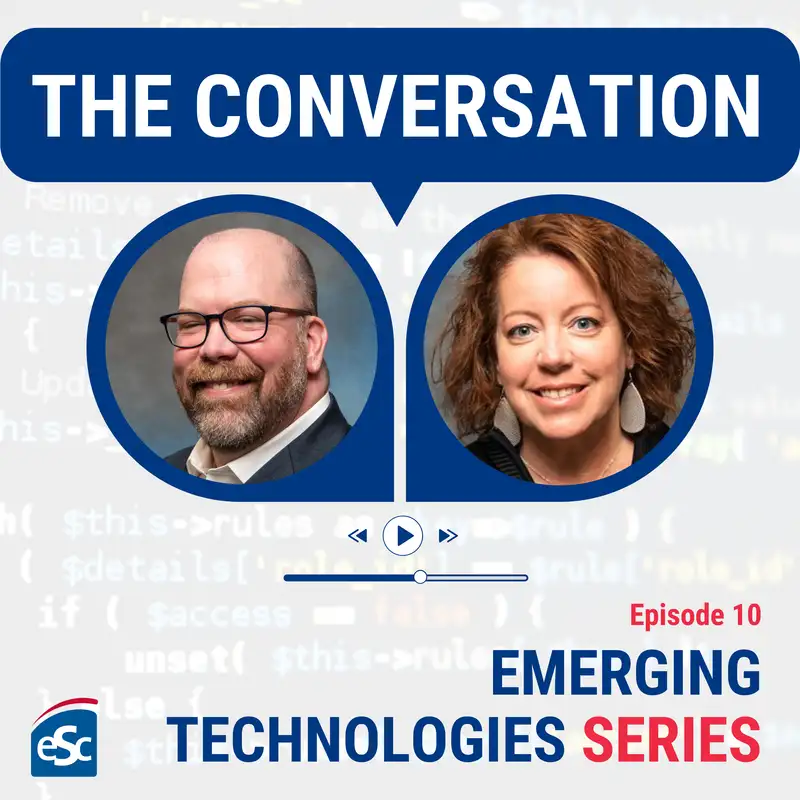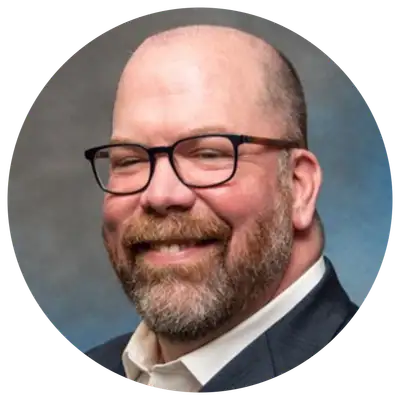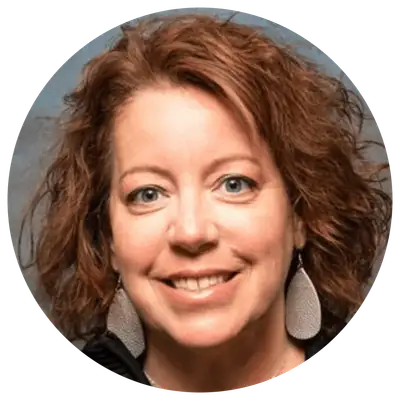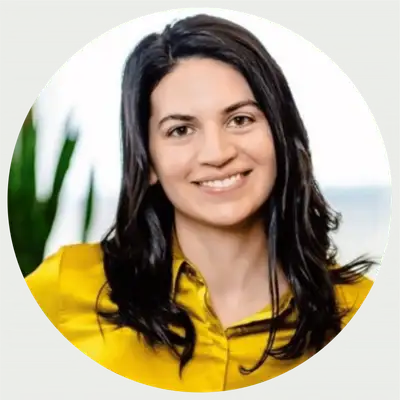
Human Centered Design with Smart Columbus
Andreya Veintimilla:
How can we leverage technology to address broad community challenges?
Speaker 2:
That was Andreya Veintimilla, Design Research Lead at Smart Columbus. On this episode of the conversation, John and Rachel, dive into the world of human-centered design and explore how it plays a role in project development. Let's dive in.
John Hambrick:
Well, hello and welcome back to the conversation, Ohio Voices in Education, igniting ideas, inspiring change. Welcome back with my esteemed colleague, Rachel Daniels, so glad you're here, and we are having, I think, an incredibly insightful conversation today with Andreya Veintimilla. She is with Smart Columbus. She is the Design Research Lead at Smart Columbus. And I'm here to say smart Columbus is more than just an affirmation. So Andrea, if we can as we start this, would you mind sharing a little bit about yourself, your role, and a little bit of background on Smart Columbus?
Andreya Veintimilla:
Yes, thank you for having me. As you said, I am the Design Research Lead at Smart Columbus, and my background is actually in architecture. That's how I started out. I think that's relevant to where I am now. I lead human-centered design efforts both internally and externally at Smart Columbus. So really what that means is that I seek to center those who are closest to the problems or the opportunities that we are working on at every step of the project, design, development, and implementation cycle.
Smart Columbus is a community innovation lab and we're pretty unique. We started out, if you are familiar at all with Smart Columbus, we won the Department of Transportation Smart Cities challenge back in 2016. And all of that work was really around advancing mobility technology. But since 2020, we've really evolved as an organization to really broaden our mission to be beyond mobility and to really look at the intersection of community and technology.
And so we are a neutral ecosystem convener. We sit within the Columbus partnership, so we are not part of the government. We are a public-private partnership that lives within a regionally focused group of organizations that are all working to advance prosperity for central Ohio. Smart Columbus's team specifically works on the emerging technology piece of that.
How can we leverage technology to address broad community challenges? Challenges that maybe wouldn't have an owner or someone to lead it otherwise. And so those come to us in lots of different ways, but they tend to be big, complex, wicked multi-stakeholder challenges.
John Hambrick:
I remember when you first launched and you had those autonomous shuttles that took our community members around the city for quite the tour. Those were fun early days with Smart Columbus.
Andreya Veintimilla:
Yes. It's funny autonomous vehicles, it feels like they're everywhere in San Francisco and Texas and Arizona, but at the time, we were really the first to pilot such a technology in an actual city. So at that time it was pretty innovative.
Rachel Daniels:
Well, Andrea, I'm curious to think about how your work intersects with local schools. And many of our districts have adopted design cycles to help with student projects. How does Smart Columbus approach project development? Talk to us about that.
Andreya Veintimilla:
Absolutely. So we always say that we work with and through and for community. And so the things that we work on come from the community. They aren't things that Smart Columbus identifies as like, "Oh, this is an interesting thing that we want to work on." It really comes from our partnerships and our relationships in the public, private, and nonprofit sector. And we do community listening in a number of ways to identify those big, wicked challenges.
And a lot of times those are coming to us already pretty well scoped as a problem from a community partner. They, a lot of times, have already done some research around the problem. And we come in as this innovation lab that can really take it forward to a solution. And that's when we bring in our human centered design process to that. We really leverage a ethnographic research approach to really understand all the context around an opportunity and a challenge.
Why is it a problem? Who is it a problem for? How many stakeholders touch this particular problem and in what ways? And how is it going to impact the community if we work on this, this challenge? And so we do that through all kinds of different research, whether it's interviews with residents and experts and stakeholders. It could be taking in research from other sources like universities or national studies that have been done on the topic.
Sometimes we look at best practices that other communities have done, other cities. We take in all of these things to say what is really the unique challenge here in this community and what might work in a unique way for our community? What needs to be adapted about a particular idea or solution of an idea to make it work in our specific context?
And so that happens through what we call an innovation design project life cycle that begins with research, ideation, prototyping, testing those prototypes with stakeholders, getting feedback and iterating, and that's happening cyclically. So that's happening all throughout the project until we get to something that we can really pilot and launch in a real way.
Rachel Daniels:
What I'm hearing you say is this just opportunity for authentic work and authentic learning and authentic practice being interwoven in. And I really get behind that notion that students have an opportunity to do work instead of playing school. And that's what I'm hearing you conceptualize in your words. So I appreciate that.
Andreya Veintimilla:
Absolutely.
John Hambrick:
And I hear a little humility inside of that, Andreya, of really responding to community's needs in such a deep way to then bring it back into the community. So having community drive these initiatives, would you mind sharing with our listeners what are some of your key initiatives right now? And maybe do you have a particular passion project that you would like to share?
Andreya Veintimilla:
Absolutely. I love that you mentioned humility because one of our values and guiding principles at Smart Columbus is intellectual humility and curiosity. And I think that really comes to life in a project that I'm particularly passionate about called The Community Information Exchange or the CIE. This is a project that is aiming to create a data infrastructure across the health and human services ecosystem to coordinate care across sectors, across organizations and across systems.
This project actually emerged from research that was done by the Mid-Ohio Food Collective. This was identified as a problem in the community because there's so much disconnection right now with this whole ecosystem of support, social supports. Whether it's transportation, housing, food, child care, you name it. You think of all the things that someone needs in their life to be stable and be upwardly mobile.
Those things exist in our community, but they're really hard to find and it's really hard for organizations who are providing those things to connect to other organizations to provide holistic care to someone. And so this project, we really leaned into human-centered design and co-design with residents, caseworkers, and our community-based partners. We're working with over 30 nonprofits and institutions to identify the real problem and design a solution that works from their perspective.
And I think that's where really intellectual humility and curiosity comes in because it's easy to say, "Well, we know what the problems are," especially if you're working in such a space your whole life. Sometimes you think, I know what the problems are, I know what the challenges are. It's easy to get disenchanted.
And what we were able to do through our research and our co-design with lived experience experts, so residents who have experience seeking health and human services and caseworkers who are directly interacting with those residents to find those services, what is the real experiential journey for them today? And what are all of the touch points, whether it's human, or technology, or policy that create that experience? Whether it's bad or good or disconnected or whatever.
And actually plotting that out and putting that into a narrative in a human journey of how someone is going through these experiences today, was really enlightening and helped us get momentum, alignment and motivation throughout the community to work on this problem together. So we are actually in the design and development phase of that. We are planning to launch the early phase of it, phase 1 in early 2026.
So we are doing a lot of work with our community-based organizations, residents and caseworkers to actually take some of these technology solutions that are possible and apply it to real world challenges that they're having. Whether it's, "How do I not have to spend hours on the phone waiting to find out that a service doesn't have funding or capacity anymore?" Or "How do I avoid applying and submitting the same information over and over again to multiple organizations?" And so on and so forth.
So really passionate about that one. Lots of community collaboration. I think we've been kind of an example of human centered design and co-creation in this space and quite proud of it. And it's a bit of a passion project, for sure.
John Hambrick:
So with this community information exchange and with that first launch in 2026, is there maybe a longer term goal here that's been identified on being able to share a best practice? For some of our listeners that may or may not know we have the Columbus Way. And that actually was actualized into a course being taught at Harvard Business School. So when we take these initiatives, these community partners for this information exchange, is there maybe a goal to be able to share with sister cities to Columbus?
Andreya Veintimilla:
Absolutely. Columbus isn't the first community to create such a tool. Other cities like San Diego and Rochester have developed similar community information exchange technologies. But I think that ours is unique in the way that we're developing it, in deep partnership, in collaboration and co-creation with so many different stakeholders and lived experience experts.
We are going to be doing things like sharing the successes and the methodologies of that. There's actually a national CIE conference called Civitas, we'll certainly be storytelling a lot around this. And this is going to be an ongoing tool that lives on beyond the launch phase. The big vision is that this provides the community with connected data that can provide insights into things that are happening throughout the community that we don't have access to right now, such as where are there are big holes in the ecosystem where we could focus funding? What's really working for residents over the long term journey from crisis to thriving, and what maybe isn't working so well?
How can groups of services and organizations collaborate and work together better to provide more consistent holistic pathways for residents and creating a complete journey? So those types of things that will come out of the data analytics and the connected records that will be possible through this tool will be emerging over time. But we'll certainly be sharing the successes of that.
Rachel Daniels:
Well, let me ask this. Are there any other exciting projects that you want to highlight before we wrap up? Maybe a couple bullet points of some things on the horizon?
Andreya Veintimilla:
We are very much interested in emerging technology at this point in time. There's a lot of buzz going on around artificial intelligence, climate technology, automation, and I think what really excites me is to be in this early exploration and discovery space again. And we're starting to do that through some interesting partnerships with universities like Ohio State and some corporate partnerships like Honda.
Where we're looking to really look at our community as a living lab and start to incubate projects that we can test out or bring to a community problem like a real community problem. There's a Rapid Innovation course at Ohio State. There's a Justice Tech program at Ohio State that are groups of students working on interesting, innovative technologies, but they're wanting to apply them to a real world context that we can provide.
So I think that's interesting to me is to bring partners together that have maybe expertise in technology that we don't have in-house, but we can bring the community challenge and we can partner together to really find those intersections of technology for community good and what's next beyond the portfolio of projects we have active right now.
Rachel Daniels:
We're living in such interesting times that it's hard to predict what's next because so many things are so rapidly changing, and it takes us back to that notion that the more opportunities we give our students for authentic learning and leaning into the new things that are coming down the pike, the better prepared they are to be inquisitive and to be analytical in their thinking and prepared for the unknowns that really are in front of us because things rapidly change so quickly. Well, as we wrap up our podcast here, any final thought or lesson that you want to leave with our listeners?
Andreya Veintimilla:
As you mentioned, it's hard to predict the future, and there's a lot of shiny objects out there right now in technology, right? I am very passionate about human-centered technology and human-centered artificial intelligence at this current moment. So I would just ask the audience to think about, as we design and implement new technologies, how might we ensure that we're not just advancing what's possible, chasing those shiny objects, but truly exploring what is beneficial and what is needed from a human perspective?
What is our community struggling with? What do we need to solve? What can be made better? And how can we leverage technology and adapt technology to that context rather than trying to find... having this hammer and then going around and trying to find the nail, what's the right nail that is the right fit for that hammer?
Rachel Daniels:
I love that. I've been leaning into, in the work of our podcast, learning lots of things I didn't know before, and what I'm thinking a lot about is this notion that just because you can do a thing doesn't mean you should do a thing. Just because a technology is possible, is it the right thing at the right time, and what is the cost?
Andreya Veintimilla:
Exactly.
Rachel Daniels:
Everything has a cost, right?
Andreya Veintimilla:
Yeah.
Rachel Daniels:
Well, gosh, Andrea. Thank you so much for this riveting and interesting conversation. The more our podcasts go on, the more I learn and realize how much more learning there is out there for me to do. So we are so thankful that you were able to join us today.
To our listeners, thank you so much for joining in. Check out our show notes for resources and ways to learn more about Smart Columbus. For John, this is Rachel, stay curious and keep up the conversation.
Creators and Guests


